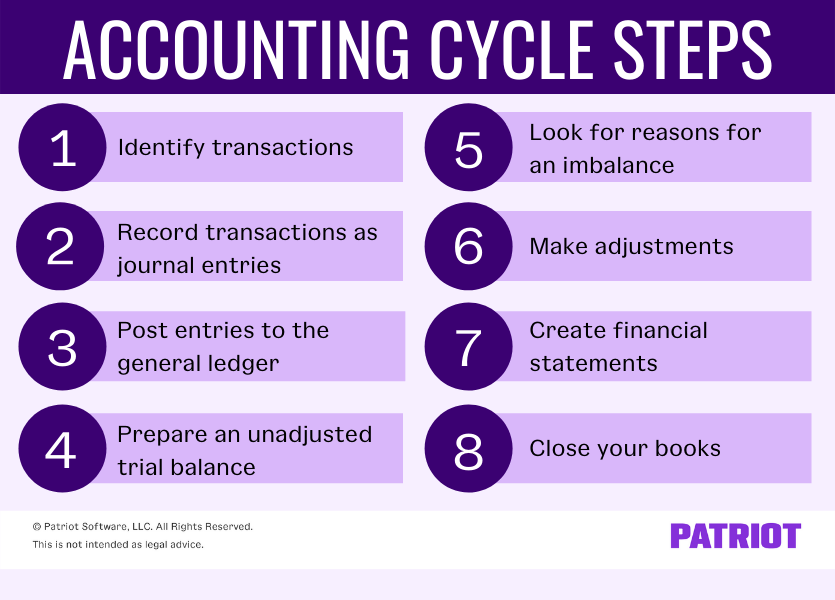
Essentially, it is a huge compilation of all transactions recorded on a specific document or in accounting software. The accounting cycle incorporates all the accounts, journal entries, T accounts, debits, and credits, adjusting entries over a full cycle. A typical accounting cycle is a 9-step process, starting with transaction analysis and ending with the preparation of the post-closing trial balance. From small LLCs to large corporations, all businesses use some form of the traditional accounting cycle. Small business owners might manage it via Excel sheets or by hand with a traditional ledger. But, it’s much easier to record, track, and analyze financial results using automated accounting software.
Identify and Analyze Business Transactions

When you record all transactions in the general journal, now, is the time to post these all transactions in the appropriate T account (General Ledger). At the end of the accounting period, companies must prepare financial statements. Public entities need to comply with regulations and submit financial statements before specified deadlines. A business can conduct the accounting cycle monthly, quarterly or annually, depending on how often the company needs financial reports. They can then use the data to assess the company’s financial health. They are prepared at the beginning of the new accounting period to facilitate a smoother and more consistent recording process, especially if the company uses a cash-basis accounting system.
Prepare an Unadjusted Trial Balance
If you buy some new business cards, for example, your marketing expense account is debited, and your bank account is credited. Or, if you receive a payment, your sales revenue is credited while your bank account is debited. If you need a bookkeeper to take care of all of this for you, check out Bench. We’ll do your bookkeeping each month, producing simple financial statements that show you the health of your business. You post an entry to the general ledger by adding it to the relevant account. Although the accounting cycle is like the heartbeat of monitoring your business’s financial health, there are drawbacks worth noting.
Try accounting software to lighten the load
This step also allows businesses that use accrual accounting to adjust for revenue and expenses. The accounting cycle is a series of steps starting with recording business transactions and leading up to the preparation of financial statements. This financial process demonstrates the purpose of financial accounting–to create useful financial information in the form of general-purpose financial statements.
An accounting period is the time period that financial statements refer to. You have to make sure that all transactions are recorded in a timely manner so that they can be reported. When errors are discovered, correcting entries are made to rectify them or reverse their effect. Take note however that the purpose of a trial balance is only test the equality of total debits and total credits.
- Temporary accounts include income, expense, and withdrawal accounts.
- Think of the general ledger as a summary sheet where all transactions are divided into accounts.
- One of the most common to be referenced is the cash account, which tells a business how much cash is available at any time.
- Utilizing the Month End Close Checklist, organizations gain access to a detailed project plan guiding accounting teams through all necessary tasks for a seamless month-end close.
- At the end of the accounting period, you’ll prepare an unadjusted trial balance.
- This means your books are up to date for the accounting period, and it signifies the start of the next accounting cycle.
Generally accepted accounting principles (GAAP) require public companies to use accrual accounting for their financial statements, with rare exceptions. Each step in the accounting cycle is equally important, but if the first step is done incorrectly, it throws off all subsequent steps. If you don’t track your transactions accurately, you won’t be able to create a clear accounting picture. Creating an accounting process may require a significant time investment. Setting up an effective process and understanding the accounting cycle can help you produce financial information that you can analyze quickly, helping your business run more smoothly. Identifying and solving problems early in the accounting cycle leads to greater efficiency.
Essentially, allan accounting and tax solutions represents a carefully orchestrated series of steps that converts raw financial data into meaningful and comprehensible reports. Understanding the accounting cycle is important for anyone in the world of business. Through accounting, financial responsibility can be taken by a company. It allows them to look at the bigger picture, and see how they’re doing business. Without accounting, the financial position of a business cannot be analyzed.
This allows accountants to program cycle dates and receive automated reports. A cash flow statement shows how cash is entering and leaving your business. While the income statement shows revenue and expenses that don’t cost literal money (like depreciation), the cash flow statement covers all transactions where funds enter or leave your accounts. A business starts its accounting cycle by identifying and gathering details about the transactions made during the accounting period. When identifying a transaction, you’ll need to determine its impact.
It is important to set proper procedures for each of the eight steps in the process to create checks and balances to catch unwanted errors. If you have debits and credits that don’t balance, you have to review the entries and adjust accordingly. The first step in the accounting cycle is to identify your business’s transactions, such as vendor payments, sales, and purchases. It’s helpful to also note some other details to make it easier to categorize transactions. When transitioning over to the next accounting period, it’s time to close the books.
